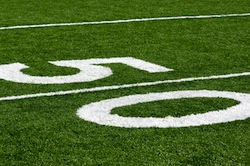
Jun 12, 2013 • 4 min read
Synthetic Turf Fields: Friend or Foe?
 It’s summer and temperatures across the country are soaring into the triple digits. Most of us are doing everything we can to stay cool and indoors, out of the scorching heat, but it’s ‘high season’ for sports tournaments. That means hoards of young and teenage athletes are participating in baseball, soccer, lacrosse, softball, and other field sport games from early morning until sundown–and often even later, with lighted fields.
It’s summer and temperatures across the country are soaring into the triple digits. Most of us are doing everything we can to stay cool and indoors, out of the scorching heat, but it’s ‘high season’ for sports tournaments. That means hoards of young and teenage athletes are participating in baseball, soccer, lacrosse, softball, and other field sport games from early morning until sundown–and often even later, with lighted fields.
While some of these tournaments are held on natural grass fields, most are not. In fact, the growing number of field complexes built specifically for tournament hosting (e.g., the ‘Big League Dreams’ sports parks across California, Texas, and Arizona) all use artificial turf throughout their facilities.
A few weeks ago I mentioned how artificial turf fields, which can be nearly 86 degrees hotter than natural grass fields, can be a contributing factor in heat-related illnesses among young athletes (You can view the post here: Staying Hydrated, Happy, and Healthy For the Summer Sports Season). Experts call this the ‘heat island’ effect, and, interestingly, these synthetic turf fields not only impact the players on the field, but the spectators as well: the turf causes a rise in the temperature of the stadium surrounding the field too! So, it’s important to think about staying hydrated at these complexes, even if you’re just watching from the stands.
If your child — or team — is playing on artificial turf, there are two other important factors to consider. One, injury rates — to legs and feet — have been shown to rise in players who play on artificial turf. Researchers studying National Football League (NFL) injuries found that players were 27 percent more likely to injure a lower extremity when playing on artificial turf (FieldTurf, in this case) instead of on natural grass. Even more concerning, especially for parents of soccer players, was that the researchers found an 88 percent increased risk of an ACL (anterior cruciate ligament) injury and a 32 percent greater risk of an ankle sprain, when the athletes played on synthetic turf.
A final factor to think about when your child is playing on artificial turf is that the turf can harbor biological contaminants — blood, sweat, saliva, and animal droppings — unless sprayed down and cleaned on a regular basis. “While natural grass self-cleans, synthetics, on the other hand, have moisture and heat with no microbial system. They are a perfect breeding ground for bacteria, viruses, mold, and mildew,” says Cassy Aoyagi, president of FormLA Landscaping, a sustainable landscaping firm in Los Angeles, CA.
Many experts recommend that, at a minimum, the turf fields should be washed down prior to and after each game to reduce the transmission of contaminants and germs, but we all know that’s highly unlikely. Some experts even suggest a daily intensive scrubbing with bacteria-killing cleanser to reduce the spread of germs. Again, our friends at the NFL are leading the way in research, having funded a University of Toledo study to determine the link between staph infections and synthetic turf fields.
At the very least, parents should take “turf burns” and “strawberries” seriously, making sure to disinfect them immediately after play. Wash uniforms after every game and, of course, make sure your athlete washes his or her hands well after playing on synthetic turf. Good old-fashioned hand-washing is still the best prevention for the spread of germs, on and off the field.
This post was originally published on August 5, 2011 on TeamSnap.
Emily Cohen is a freelance writer living in Berkeley, California. An avid tennis player and swimmer, Emily has a son who plays varsity high school baseball and a daughter who plays Class I soccer and middle school volleyball. She has been a team manager for a number of her children’s sports teams. You can find Emily’s blog about team management and youth sports parenting here at tsblogadmin.wpengine.com. Follow her on Twitter at @emilygcohen or email her at emily@emily-writes.com
